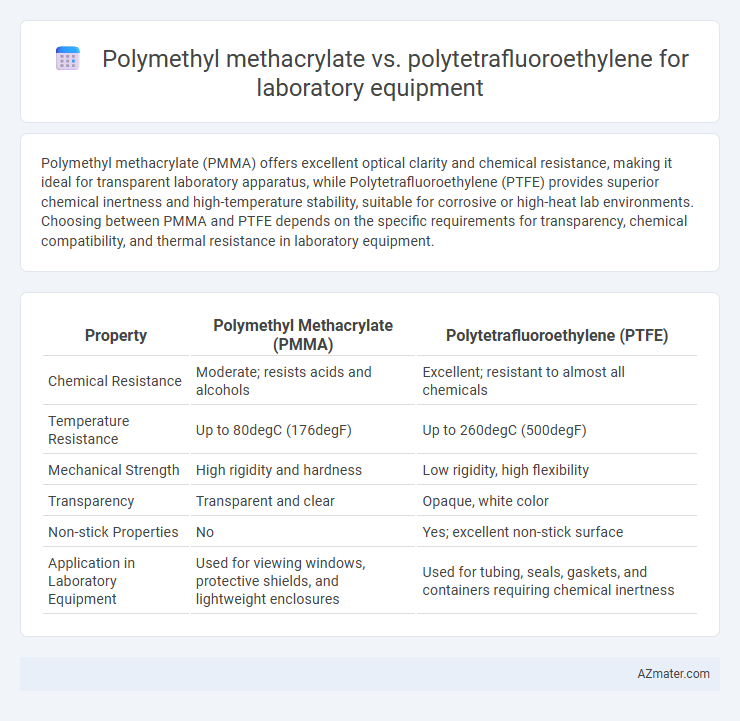Polymethyl methacrylate (PMMA) offers excellent optical clarity and chemical resistance, making it ideal for transparent laboratory apparatus, while Polytetrafluoroethylene (PTFE) provides superior chemical inertness and high-temperature stability, suitable for corrosive or high-heat lab environments. Choosing between PMMA and PTFE depends on the specific requirements for transparency, chemical compatibility, and thermal resistance in laboratory equipment.
Table of Comparison
| Property | Polymethyl Methacrylate (PMMA) | Polytetrafluoroethylene (PTFE) |
|---|---|---|
| Chemical Resistance | Moderate; resists acids and alcohols | Excellent; resistant to almost all chemicals |
| Temperature Resistance | Up to 80degC (176degF) | Up to 260degC (500degF) |
| Mechanical Strength | High rigidity and hardness | Low rigidity, high flexibility |
| Transparency | Transparent and clear | Opaque, white color |
| Non-stick Properties | No | Yes; excellent non-stick surface |
| Application in Laboratory Equipment | Used for viewing windows, protective shields, and lightweight enclosures | Used for tubing, seals, gaskets, and containers requiring chemical inertness |
Introduction to PMMA and PTFE in Laboratory Equipment
Polymethyl methacrylate (PMMA) is a transparent thermoplastic widely used in laboratory equipment due to its excellent optical clarity, lightweight nature, and chemical resistance to acids and alkalis. Polytetrafluoroethylene (PTFE), known for its exceptional non-stick properties, chemical inertness, and high-temperature resistance, is commonly utilized in lab applications requiring strong resistance to corrosive chemicals and solvents. Both PMMA and PTFE serve critical roles in laboratory environments, with PMMA favored for visibility-oriented tools and PTFE preferred for chemical-resistant components.
Chemical Properties: PMMA vs. PTFE
Polymethyl methacrylate (PMMA) offers excellent transparency and moderate chemical resistance, making it suitable for applications involving dilute acids, bases, and alcohols; however, it is vulnerable to strong solvents like acetone and aromatic hydrocarbons. Polytetrafluoroethylene (PTFE) exhibits exceptional chemical inertness, resisting virtually all chemicals including strong acids, bases, and solvents, which makes it ideal for aggressive chemical handling and high-corrosion environments. The superior chemical stability and non-reactivity of PTFE surpass PMMA, especially in laboratory settings requiring exposure to harsh reagents or elevated temperatures.
Mechanical Strength and Durability Comparison
Polymethyl methacrylate (PMMA) offers moderate mechanical strength with good rigidity and impact resistance, making it suitable for transparent laboratory equipment requiring clarity and moderate durability. Polytetrafluoroethylene (PTFE), known for exceptional chemical resistance and low friction, exhibits superior mechanical durability under harsh chemical exposure but has lower tensile strength compared to PMMA. For laboratory applications demanding high mechanical strength and transparency, PMMA excels, while PTFE provides enhanced durability in chemically aggressive environments despite its relatively lower mechanical rigidity.
Thermal Resistance and Stability
Polytetrafluoroethylene (PTFE) offers superior thermal resistance with an operating range up to 260degC, making it highly stable for laboratory equipment exposed to extreme heat. Polymethyl methacrylate (PMMA) has lower thermal resistance, typically up to 80degC, limiting its use in high-temperature applications. PTFE also exhibits excellent chemical stability and low thermal expansion compared to PMMA, enhancing durability and performance under thermal stress.
Transparency and Optical Clarity
Polymethyl methacrylate (PMMA) offers superior transparency and optical clarity compared to polytetrafluoroethylene (PTFE), making PMMA ideal for applications requiring clear visibility and light transmission in laboratory equipment. PMMA has a transmittance of around 92%, while PTFE is opaque with very low light transmission, limiting its use where optical clarity is essential. The high refractive index of PMMA enhances visual precision, whereas PTFE is mainly valued for its chemical resistance and low friction properties rather than transparency.
Resistance to Chemicals and Solvents
Polymethyl methacrylate (PMMA) exhibits moderate resistance to a wide range of chemicals, including diluted acids, bases, and alcohols, but it can degrade when exposed to strong solvents such as acetone and aromatic hydrocarbons. Polytetrafluoroethylene (PTFE) offers superior chemical resistance, withstanding aggressive solvents, strong acids, bases, and oxidizing agents without degradation, making it ideal for harsh chemical environments in laboratory settings. The exceptional inertness of PTFE compared to PMMA ensures longer durability and reliability when handling corrosive substances in laboratory equipment.
Ease of Fabrication and Machinability
Polymethyl methacrylate (PMMA) offers superior ease of fabrication compared to polytetrafluoroethylene (PTFE) due to its excellent machinability, allowing precise cutting, drilling, and shaping with standard tools. PTFE's high chemical resistance and low friction make it challenging to machine, often requiring specialized equipment and slower processing speeds to prevent deformation. The thermoplastic nature of PMMA enables efficient thermoforming and bonding, whereas PTFE's high melting point and elasticity complicate fabrication and limit design flexibility in laboratory equipment manufacturing.
Cost Analysis and Economic Considerations
Polymethyl methacrylate (PMMA) offers a lower initial cost compared to Polytetrafluoroethylene (PTFE), making it a budget-friendly option for laboratory equipment with moderate chemical exposure. PTFE, although more expensive upfront, provides superior chemical resistance and durability, reducing long-term replacement and maintenance expenses in highly corrosive environments. Economic considerations favor PMMA for cost-sensitive applications with limited chemical stress, while PTFE is justified in high-performance settings where longevity and resistance minimize overall operational costs.
Common Laboratory Applications for PMMA and PTFE
Polymethyl methacrylate (PMMA) is widely used in laboratory equipment for its excellent optical clarity and chemical resistance, making it ideal for cuvettes, petri dishes, and fume hood panels. Polytetrafluoroethylene (PTFE) excels in applications requiring superior chemical inertness and high-temperature resistance, such as tubing, seals, and gaskets in corrosive environments. Both materials serve crucial but distinct roles: PMMA for visibility and moderate chemical exposure, PTFE for high-performance, chemically aggressive conditions.
Choosing the Right Material: PMMA or PTFE for Your Laboratory Needs
Polymethyl methacrylate (PMMA) offers excellent optical clarity and good chemical resistance, making it ideal for applications requiring transparency and moderate exposure to solvents. Polytetrafluoroethylene (PTFE) provides superior chemical inertness, high thermal stability, and non-stick properties, suited for aggressive chemical environments and high-temperature processes. Selecting between PMMA and PTFE depends on specific laboratory requirements such as chemical compatibility, temperature tolerance, and visibility needs.

Infographic: Polymethyl methacrylate vs Polytetrafluoroethylene for Laboratory equipment
 azmater.com
azmater.com